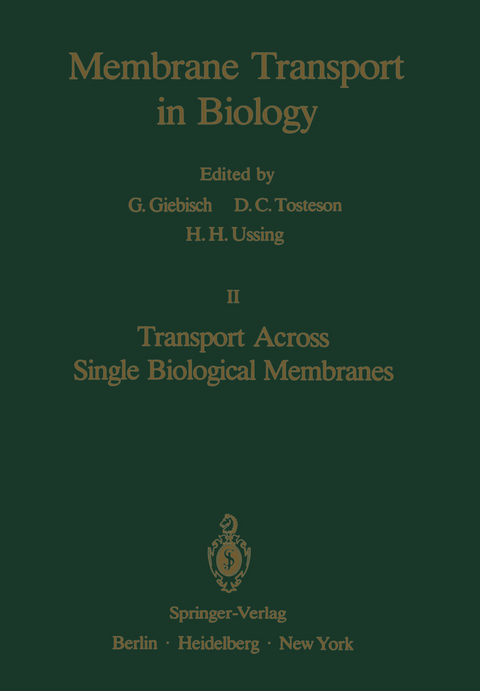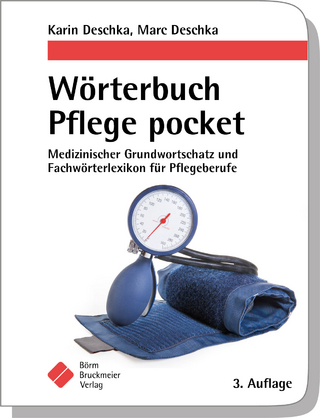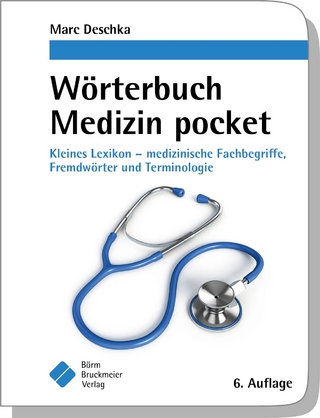
Transport Across Single Biological Membranes
Springer Berlin (Verlag)
978-3-642-46377-8 (ISBN)
This second Volume in the series on Membrane Transport in Biology contains a group of essays on transport across single biological membranes separating the inside and outside of cells or organelles. We have not attempted to include material on all types of plasma and intracellular membranes, but rather have emphasized structures which have been studied relatively thoroughly. Four chapters describe transport of different types of molecules and ions across the plasma membranes of mammalian red cells. Two essays concern the excitable membranes of nerve and muscle cells while the remaining four chapters treat transport across several types of intracellular membranes. Water makes up more than two-thirds of the mass of most living cells. The transport of water between the inside and outside of cells and organelles is important for the function of these structures. As a result of investigations in many laboratories over the past four decades, our picture of the water permea bility of the red cell membranes is rather detailed when compared to the water permeability of other biological membranes. In Chapter 1, R. I. Macey describes this picture and also considers the permeability of red cell membranes to non electrolytes, including metabolic substrates such as sugars, amino acids, purines and nucleosides.
1 - Transport of Water and Nonelectrolytes Across Red Cell Membranes.- A. Introduction.- B. Osmotic Equilibria.- C. Methods for Permeability Measurements.- D. Kinetics of Osmotically Induced Volume Changes.- E. Water Permeability.- F. Nonelectrolyte Permeability.- G. Water-Solute Flow Interactions.- Acknowledgements.- References.- 2 - Transport of Anions Across Red Cell Membranes.- A. Introduction.- B. The Fixed-Charge Model.- C. The Concentration Dependence of Anion Fluxes.- D. Temperature Dependence of Anion Exchange.- E. Inhibitors of Anion Exchange.- F. The Titratable Carrier: New Evidence.- G. The Relationship Between the Net Pathway and the Exchange Pathway for Anions in Red Blood Cells.- H. Membrane Structure and Biochemistry Related to Anion Transport.- References.- 3 - Passive Cation Fluxes in Red Cell Membranes.- A. Introduction.- B. The Passive Fluxes of Na+and K+in Red Cell Membranes.- C. A Unified View of Na+ and K+ Transport in Red Cells.- D. A Ca++ -Sensitive K+-Permeability Mechanism in the Red Cell Membrane.- Acknowledgements.- References.- 4 - Active Cation Transport in Human Red Cells.- A. Introduction.- B. Active Na+-K+ Transport in Human Red Cells.- C. Active Ca++Transport in Human Red Cells.- References.- 5 - Transport Across Axon Membranes.- A. Introduction.- B. Methods for Transport Studies.- C. Transport During Bioelectric Activity.- D. Active Transport.- References.- 6 - Ionic Movements Across the Plasma Membrane of Skeletal Muscle Fibers.- A. Introduction.- B. Sodium Movements.- C. Potassium Movements.- D. Chloride Movements.- E. List of Symbols.- Acknowledgements.- References.- 7 - Transport Across Mitochondrial Membranes.- A. Introduction.- B. Mitochondrial Structure, Function and Transport.- C. H+ Transport.- D. MonovalentCation Transport.- E. Transport of Ca++ and Other Divalent Cations.- F. Transport of Anion and Metabolites.- G. Transport of Adenine Nucleotides.- References.- 8 - Transport Across Sarcoplasmic Reticulum in Skeletal and Cardiac Muscle.- A. Introduction.- B. Methods of Preparation.- C. Composition of the SR Membrane.- D. Structural Organization of the SR Membrane.- E. Ca2+ Binding and Ca2+ Transport.- F. Mechanisms of ATP Hydrolysis.- G. Ca2+ Release.- H. Experiments on Reconstitution.- J. Activity of Cardiac Microsomes.- K. Conclusions.- Acknowledgements.- References.- 9 - Transport Across the Lysosomal Membrane.- A. Introduction.- B. The Internal pH of the Lysosome.- C. Mechanisms of Accumulation of Protons in Lysosomes.- D. An ATP-Dependent Proton Pump.- E. The Accumulation of Cationic Dyes and Drugs by Lysosomes.- F. The Permeability of Lysosomal Membranes to Solutes.- References.- 10 - Transport Across Chloroplast Envelopes - The Role of Phosphate.- A. Introduction.- B. The Experimental Basis of Transport Theory.- C. Induction, Autocatalysis, and Orthophosphate.- D. The Phosphate Translocator.- E. Orthophosphate and Pyrophosphate.- F. Control of Photosynthesis by Phosphate Transport.- G. Manipulation of Cytoplasmic Orthophosphate.- H. Orthophosphate and Whole-Plant Physiology.- J. Conclusions.- Acknowledgements.- References.
| Erscheint lt. Verlag | 23.3.2012 |
|---|---|
| Reihe/Serie | Membrane Transport in Biology |
| Zusatzinfo | XX, 446 p. |
| Verlagsort | Berlin |
| Sprache | englisch |
| Maße | 170 x 244 mm |
| Gewicht | 806 g |
| Themenwelt | Medizin / Pharmazie ► Allgemeines / Lexika |
| Schlagworte | biochemistry • Biology • Cell • cell membrane • Chemistry • Dialysis • Ionentransport • Membrane • membrane potential • Membrantransport • mitochondria • Organelle • Physiology • Protein • Red blood cells • termination • Transport • Zellmembran |
| ISBN-10 | 3-642-46377-0 / 3642463770 |
| ISBN-13 | 978-3-642-46377-8 / 9783642463778 |
| Zustand | Neuware |
| Haben Sie eine Frage zum Produkt? |
aus dem Bereich


